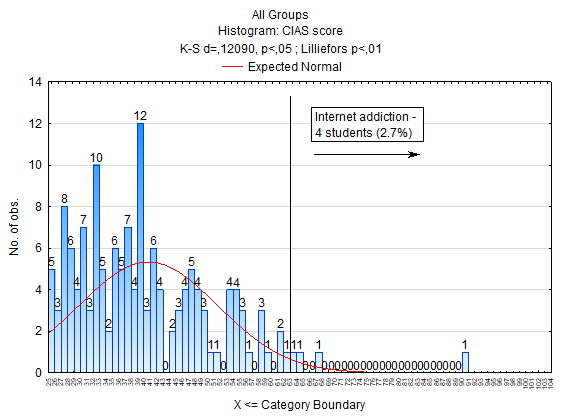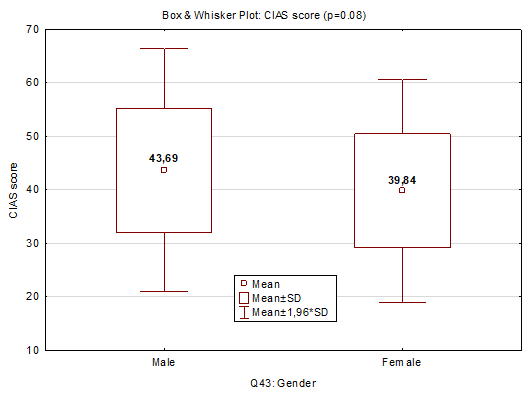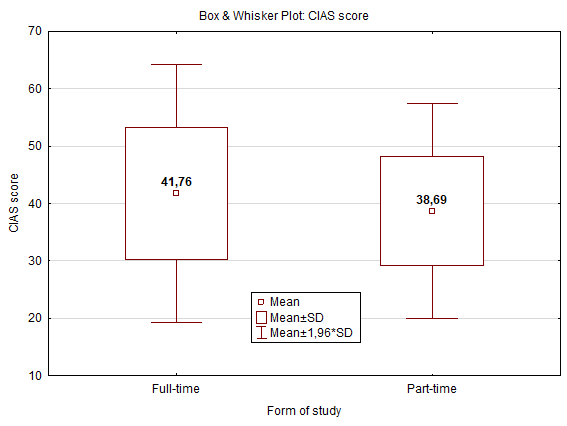Abstract
The paper describes the first part of a research study aimed at addiction to the internet, computer games, and online communication among students of teacher training courses at Palacký University Olomouc, Czech Republic. The research method was the standardized CIAS scale. Addictive behaviour among students in relation to computer games was assessed by a questionnaire designed by the authors. Moreover, selected online activities and other data were analysed. The research sample in the preliminary research comprised 146 students of various study programmes. Internet addiction was observed in 2.7% of students. A higher degree of internet addiction was observed in men (score 44) and younger students (42), but the difference was not statistically significant. The Generalized k-Means Cluster Analysis suggested two clusters by respondents’ addiction. The first cluster comprised about 26% of students, mostly men, who showed a higher internet addiction score (46) and a higher computer game score (11). Each day on average they played for 98 minutes, of which 55 minutes was online. They did not pursue leisure activities, spent less time communicating using their mobile phone, and read in their free time. The second cluster comprised about 74% of students, mostly women, who show a higher internet addiction score (39) and a lower computer game score (3). Each day on average they played for 16 minutes, of which 9 minutes was online. They pursued leisure activities, spent more time communicating using their mobile phone, and went out with friends in their free time.
Keywords: Internet addictionCIASstudentsGeneralized k-Means Cluster Analysis
Introduction
Generally, internet addiction is defined as excessive use of the internet that causes psychological, social and work-related or school-related complications. Research has shown that people do not develop “internet addiction” but rather addiction to specific internet applications or websites (Škařupová, 2015). Internet addiction, also known as internet addiction disorder, is pathological use of internet in all forms, including playing web games, chatting, reading e-mails, surfing, etc. In a broader sense, this disorder is classified as addiction to the so-called virtual drugs, which also includes mobile telephones and TV (Young, 2017). However, experts agree that the concept of internet addiction is not very precise; instead, they recommend to refer to addictive behaviour (Blinka, Ševčíková, Škařupová, Vondráčková, & Licehammerová, 2015).
The most addictive applications and websites are those that allow two-way communication. Generally, there are 3 basic types of internet addiction:
Online game addiction. This usually includes the so-called multiplayer RPG online games, i.e. hero games for more players.
Online communication addiction. This category includes online communication, whether with real or internet friends. This also includes emailing, chatrooms, discussion fora, ICQ, Skype or various social networks such as Facebook and Twitter.
c) Addiction to websites with pornographic content.
Problem Statement
Among the general population, the most-at-risk group in terms of addictive behaviour comprises university students regarding their use of information technology and especially the internet (Škařupová, 2015). The high prevalence is usually attributed to students’ easy access to the internet, flexible daily programme, and by the fact that after enrolling in university, most of them are in a new environment without their previous social ties and start to build new relationships and social status, which is largely facilitated by the internet.
The prevalence of addictive behaviour in relation to internet use among foreign university population ranges between 6 and 13% (Šmahel, Vondráčková, Blinka, & Godoy-Etcheverry, 2009⁏ Weinstein et al., 2015⁏ Seki, Hamazaki, Natori, & Inadera, 2019⁏ Laconi et al., 2019). The problem is however that only a very small part of internet users are aware of the negative effects of this behaviour on their lives. Students with risk behaviour in relation to the internet most often use two-way communication applications such as chatrooms, emails, and interactive computer games (Škařupová & Blinka, 2015).
The most frequent negative implications of addictive behaviour in the context of internet use is worse academic achievement, late arrivals or absence in classes, worse eyesight, sleep deprivation, backache, hurting hands and fingers, and overall fatigue. However, the impact in the social area is disputable because some studies suggest a positive effect of internet use on interpersonal relationships, while others suggest negative implications, such as greater social isolation and a decreased number of new relationships (Blinka et al., 2015).
Research Questions
The following research questions were formulated for the purposes of the research:
What is the degree of internet addiction among students of teacher training courses?
Is the degree of internet addiction among students of teacher training courses dependent on gender?
Is the degree of internet addiction among students of teacher training courses dependent on their form of study?
Are there typical groups of students of teacher training courses by the degree of their internet addiction and addictive behaviour in relation to playing computer games and online communication?
Purpose of the Study
The paper aims to identify the risks posed by the increasing use of information and communication technologies (ICT) and internet in everyday university students life (Kopecký, 2013). Specifically, the paper focuses on the negatives associated with playing computer games (Blinka, Škařupová, & Mitterova, 2016) and internet addiction (Young, 2017). Currently, everyday use of the internet is an absolute necessity for university students, even in their free time (Cerniglia et al., 2016). Unfortunately, students often play computer games and show signs of addictive behaviour (Chráska, 2016a). Generally, this is referred to as Problematic Internet use (PIU), not only internet addiction (Laconi et al., 2019).
Research Methods
In the present research, the following two principal research methods were used. The first standardized CIAS method (see section
The Chen Internet Addiction Scale
To assess the degree of internet addiction, an internet addiction scale was used (The Chen Internet Addiction Scale, CIAS). The scale was developed in 2003 by Dr. Sue-Huei Chen and his colleagues (National Taiwan University, Taipei) in order to assess the severity of internet addiction. This scale comprises 26 items (see Tab.
Prior to the evaluation of the CIAS scale its reliability was calculated (see Table.
Addictive behaviour questionnaire in relation to playing computer games
The research method to measure addictive behaviour in relation to playing computer games was a yet non-standardized questionnaire, which was based on a questionnaire used in 2016 (Chráska & Basler, 2016). For the purposes of an IGA project aimed at the issue of addiction to computer games among university students in a broader context, in 2018 the questionnaire was supplemented with additional items. The purpose of the questions was to determine detailed characteristics of the types of students by their computer game addition. Apart from these characteristics, the questionnaire focused on the degree of addictive behaviour among students in relation to playing computer games by means of 12 statements. The degree of agreement with each statement was indicated by students on a six point scale with coded answers: totally agree (value 5), agree (4), rather agree (3), rather disagree (2) disagree (1) completely disagree (0). The questionnaire was presented to students in an electronic form via a web interface. Prior to the assessment of the questionnaire its reliability was determined. The resulting value of 0.94 suggests high measurement reliability.
Description of the research sample
The first part of the research study (preliminary research) was performed among students at the Faculty of Education, Palacký University Olomouc in autumn 2018 and spring 2019. The research sample in the preliminary research comprised 146 students of various teacher training courses in the full-time (F) and part-time (P) form of study. The total planned research sample will comprise approximately 600 students. A detailed description of the research sample by gender and form of study is specified in Table
Findings
Degree of internet addiction among students of teacher training courses
The first part of the research focused on what proportion of students showed internet addiction by scoring at least 64 points. The results are shown in Figure
Internet addiction among students by gender
The results in the table


Internet addiction among students by form of study and age
The results in the table

Identification of typical groups of students of teacher training courses by the degree of their internet addiction and addictive behaviour in relation to playing computer games and online communication
To determine any typical groups of students of teacher training courses by their responses in the CIAS scale and the authors’ addictive behaviour questionnaire in relation to playing games, the Generalized k-Means Cluster Analysis was used (Chráska, 2016a). This analysis was performed using STATISTICA 13 (TIBCO Software Inc., 2017). The results are shown in Table
The results of the research suggested two groups (clusters) of students of teacher training courses according to their internet addiction and the way they approach computer games and online communication. These groups also show a completely different degree of internet addiction and computer game addition.
The first cluster comprised about 26% of students, mostly men, who showed a higher internet addiction score (46) and a higher computer game score (11). Each day on average they played for 98 minutes, of which 55 minutes was online. They did not pursue leisure activities, spent less time communicating using their mobile phone, and read in their free time.
The second cluster comprised about 74% of students, mostly women, who showed a higher internet addiction score (39) and a lower computer game score (3). Each day on average they played for 16 minutes, of which 9 minutes was online. They pursued leisure activities, spent more time communicating using their mobile phone, and went out with friends in their free time.
Conclusion
Internet addiction was observed in 2.74% of students of teacher training courses, which is less than for example in Japan (Seki et al., 2019) or in a comparable population of adults in Europe (Cerniglia et al., 2016). A higher degree of internet addiction was observed in men (score 43.69) than women (39.84), which was surprising concerning the original assumptions. A comparison of 9 European countries (Laconi et al., 2019) showed a prevalence of problematic internet use (PIU) from 14% to 55%, and was more frequent in women. This discrepancy may be caused by the teaching specialization of the research sample.
However, it is typically reported that men are a higher risk group for Internet addiction (Wenliang, Xiaoli, Cheng, Yan, & Potenza, 2019). Most studies report significant results to varying degrees, mostly suggesting a higher average male dependence rate (Cerniglia et al., 2016; Weinstein et al., 2015). However, the findings are particularly ambivalent for university students. Some studies indicate that the difference has not been demonstrated (eg Kuss et al., 2013), or has been mild (Servidio, 2014), or that the difference has not been demonstrated (Capetillo-Ventura & Juárez-Treviño, 2015).
A higher degree of internet addiction was observed among younger students (41.76) compared with older students (38.69). However, the differences were not statistically significant.
The Generalized k-Means Cluster Analysis suggested two different groups of students according to their addiction to the internet, computer games, and frequency of online activities. These groups show different addiction to the internet, computer games, and mobile phone communication by gender.
Risks and limitations of the conclusions
Regarding the partial results of the research, the research sample of students does not so far include all study specializations, which is another intervening variable.
Another limitation concerning the interpretation of the results is the CIAS scale in terms of intercultural transfer. In foreign countries, the tool has been revised – CIAS-R (Mak et al., 2014) and suggests four dimensions of internet addiction. However, in the Czech Republic, CIAS is used as a basic indicative tool to test internet addiction in humanities-oriented research.
Acknowledgments
The paper was supported by project IGA_PdF_2019_043 “Analysis of selected current issues in teaching ICT-based subjects with an emphasis on online technologies”.
References
- Blinka, L., Ševčíková, A., Škařupová, K., Vondráčková, P., & Licehammerová, Š. (2015). Online závislosti [Online addiction]. Praha: Grada.
- Blinka, L., Škařupová, K., & Mitterova, K. (2016). Dysfunctional impulsivity in online gaming addiction and engagement. Cyberpsychology: Journal of Psychosocial Research on Cyberspace, 10(3). DOI:
- Capetillo-Ventura, N., & Juárez-Treviño, M. (2015). Internet addiction in university medical students. Medicina Universitaria, 17(67), 88–93.
- Cerniglia, L., Zoratto, F., Cimino, S., Laviola, G., Ammaniti, M., & Adriani, W. (2017). Internet Addiction in adolescence: Neurobiological, psychosocial and clinical issues. Neuroscience & Biobehavioral Reviews, 76, 174-184. DOI:
- Chen, S. H., Weng, L. J., Su, Y. J., Wu, H. M., & Yang, P. F. (2003). Development of a Chinese Internet addiction scale and its psychometric study. Chinese Journal of Psychology.
- Chráska, M. jr., J. & Basler, J. (2016). Research of Computer game addiction among the 18-year old students of general upper secondary schools in the Czech Republic. In: ICERI 2016 Proceedings. Seville, 9th International Conference of Education, Research and Innovation, pp. 69-78.
- Chráska, M. (2016a). Grammar School Students and Their Typology According to Dependence on Computer Games. In SGEM 2016 Conference Proceedings. Sofia: STEF92 Technology Ltd. pp. 795-802. DOI:
- Chráska, M. (2016b). Metody pedagogického výzkumu [Methods of pedagogical research]. 2. aktual. vyd. Praha: Grada.
- Kopecký, K. (2013). Rizikové chování studentů Pedagogické fakulty Univerzity Palackého v prostředí internet [Risky behavior of students of the Faculty of Education of Palacký University in the Internet environment]. Olomouc: Univerzita Palackého v Olomouci.
- Kuss, D. J., Griffiths, M. D., & Binder, J. F. (2013). Internet addiction in students: Prevalence and risk factors. Computers in Human Behavior, 29(3), 959–966.
- Laconi, S., Urbán, R., Kaliszewska-Czeremska, K., Kuss, D. J., Gnisci, A., Sergi, I., ... & Király, O. (2019). Psychometric Evaluation of the Nine-Item Problematic Internet Use Questionnaire (PIUQ-9) in Nine European Samples of Internet Users. Front. Psychiatry,10,136. DOI:
- Mak, K. K., Lai, C. M., Ko, C. H., Chou, C., Kim, D. I., Watanabe, H., & Ho, R. C. (2014). Psychometric properties of the revised chen internet addiction scale (CIAS-R) in Chinese adolescents. Journal of abnormal child psychology, 42(7), 1237-1245. DOI:
- Seki, T., Hamazaki, K., Natori, T., & Inadera, H. (2019). Relationship between internet addiction and depression among Japanese university students. Journal of affective disorders, 256, 668-672.DOI:
- Servidio, R. (2014). Exploring the effects of demographic factors, Internet usage and personality traits on Internet addiction in a sample of Italian university students. Computers in Human Behavior, 35, 85-92.
- Škařupová, K. (2015). Internet: From Excess to Addiction (Disertation). Masarykova univerzita, Fakulta sociálních studií, Brno, Brno. http://is.muni.cz/th/43275/fss_d_b1/
- Škařupová, K., & Blinka, L. (2015). Interpersonal dependency and online gaming addiction. Journal of Behavioral Addictions, 5(1), 108–114.
- Šmahel, D., Vondráčková, P., Blinka, L., & Godoy-Etcheverry, S. (2009). Comparing Addictive Behavior on the Internet in the Czech Republic, Chile and Sweden. In G. Cardoso, A. Cheong, & J. Cole, World Wide Internet: Changing Societies, Economies and Cultures. University of Macau.
- TIBCO Software Inc. (2017). Statistica (data analysis software system), version 13. http://statistica.io.
- Weinstein, A., Dorani, D., Elhadif, R., Bukovza, Y., Yarmulnik, A., & Dannon, P. (2015). Internet addiction is associated with social anxiety in young adults. Annals of Clinical Psychiatry: Official Journal of the American Academy of Clinical Psychiatrists, 27(1), 4–9.
- Wenliang, S., Xiaoli, H., Cheng, J., Yan, Y., & Potenza, M. N. (2019). Are males more likely to be addicted to the internet than females? A meta-analysis involving 34 global jurisdictions. Computers in Human Behavior, 99, DOI:
- Young, K. S. (2017). The evolution of Internet addiction. Addictive Behaviors, 100(64), 229-230.
Copyright information

This work is licensed under a Creative Commons Attribution-NonCommercial-NoDerivatives 4.0 International License.
About this article
Publication Date
07 November 2019
Article Doi
eBook ISBN
978-1-80296-071-6
Publisher
Future Academy
Volume
72
Print ISBN (optional)
-
Edition Number
1st Edition
Pages
1-794
Subjects
Psychology, educational psychology, counseling psychology
Cite this article as:
Chráska, M. (2019). Typology Of Czech University Students By Their Internet Addiction. In P. Besedová, N. Heinrichová, & J. Ondráková (Eds.), ICEEPSY 2019: Education and Educational Psychology, vol 72. European Proceedings of Social and Behavioural Sciences (pp. 558-567). Future Academy. https://doi.org/10.15405/epsbs.2019.11.65

